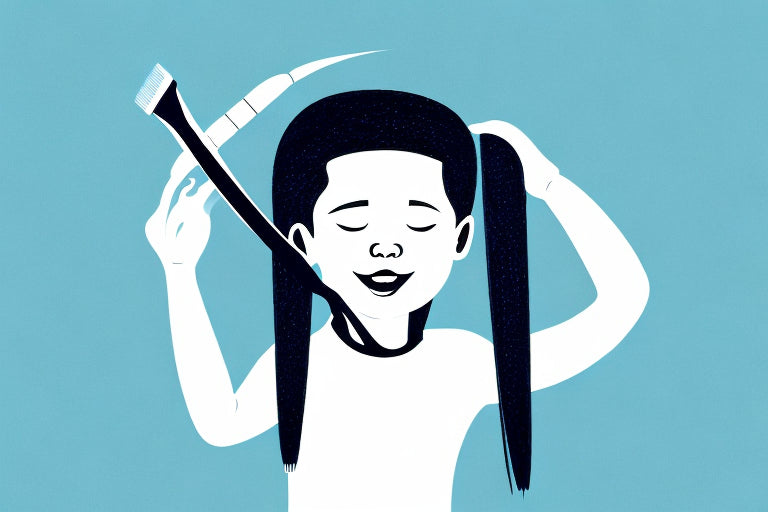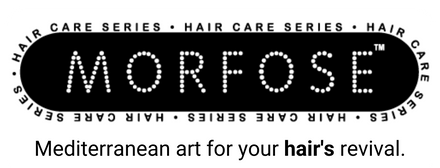Teaching Your Child Healthy Hair Care Habits: A Guide for Parents
Posted by MORFOSE COSMETICS

Teaching Your Child Healthy Hair Care Habits: A Guide for Parents
As a parent, you want your child to be healthy and happy. Part of their overall well-being includes taking care of their hair. Establishing healthy hair care habits at a young age can have numerous benefits, both for their hair and their self-esteem. In this guide, we'll explore the importance of healthy hair care habits and provide valuable tips for parents on how to teach them to their child.
Understanding the Importance of Healthy Hair Care Habits
Proper hair care is not just about looking good, but it is also essential for maintaining healthy hair and preventing damage. Hair is an essential part of our body, and it requires proper care and attention to keep it healthy and strong. When hair is healthy, it's easier to style, and it is less prone to breakage and other issues. Additionally, healthy hair can improve self-confidence and self-esteem in children, which is especially important as they navigate the challenges of growing up.
Benefits of Proper Hair Care
Healthy hair provides several benefits, such as increased manageability and improved overall appearance. When hair is healthy, it tends to be softer and more resilient, making it easier to work with. Additionally, regular hair care can help prevent issues like dandruff, dry scalp, and hair loss, which can be both uncomfortable and embarrassing.
Moreover, healthy hair can also improve the overall health of an individual. It is because the scalp is an essential part of the hair, and proper hair care can help maintain a healthy scalp. A healthy scalp promotes healthy hair growth and prevents issues like scalp infections and irritations.
Preventing Hair Damage and Scalp Issues
Regular hair care can help prevent damage to the hair and scalp. When hair is left untreated, it can become dry, brittle, and prone to breakage. To prevent these issues, parents should encourage their children to use moisturizing shampoos and conditioners. Children should also be taught to avoid excessive heat styling and use heat protectant products when styling with hot tools.
Moreover, it is crucial to maintain a healthy diet to promote healthy hair growth. A diet rich in vitamins and minerals, especially vitamin E, vitamin C, and biotin, can help promote healthy hair growth. Drinking plenty of water can also help keep hair hydrated and healthy.
In conclusion, proper hair care is essential for maintaining healthy hair and preventing damage. It is crucial to teach children healthy hair care habits from a young age to promote healthy hair growth and prevent issues like hair loss, dry scalp, and dandruff. By following healthy hair care habits and maintaining a healthy diet, individuals can enjoy soft, shiny, and healthy hair.
Establishing a Hair Care Routine for Your Child
Teaching a child to care for their hair is an important aspect of personal hygiene. It not only helps to maintain healthy hair and scalp but also instills good habits that can last a lifetime. By establishing a routine, parents can help make the process of caring for their hair simple and easy to follow. Here are some tips on how to establish a hair care routine:
Choosing the Right Hair Care Products
Choosing the right hair care products is crucial in maintaining healthy hair and scalp. Parents should aim for gentle formulas that are free from harsh chemicals and fragrances. Look for products that are specifically formulated for children, as they tend to be milder and less irritating. Additionally, always check the ingredients before making a purchase. Avoid products that contain sulfates, parabens, and alcohol as these can strip moisture from the hair and scalp.
It is also important to note that children's hair care needs can vary depending on their hair type. For example, children with curly hair require more moisture to maintain their curls, while children with straight hair may need less moisture to prevent their hair from becoming greasy.
Washing and Conditioning Techniques
When washing their hair, children should be taught to use a gentle, circular motion to massage their scalp. This helps to increase blood flow, which can promote healthy hair growth. After shampooing, they should apply conditioner, again using gentle, circular motions to distribute the product evenly. Parents should also encourage their child to rinse their hair thoroughly to ensure all products are removed.
It is important to note that children do not need to wash their hair every day. In fact, over-washing can strip the hair of its natural oils, leading to dryness and damage. Depending on their hair type, children may only need to wash their hair once or twice a week.
Detangling and Brushing Tips
Detangling can be a challenging part of hair care, but it doesn't have to be. Parents should encourage their children to start detangling from the ends of their hair and work their way up to the roots. Using a wide-tooth comb or a detangling brush can help make the process easier. Parents should also avoid over-brushing their child's hair, as this can cause unnecessary breakage and damage.
It is important to note that brushing or combing wet hair can cause more damage than brushing dry hair. Parents should encourage their child to wait until their hair is dry or slightly damp before detangling.
Styling Tips
Styling a child's hair can be a fun and creative process. However, it is important to keep in mind that some styles can be damaging to the hair if done too frequently or too tightly. Parents should avoid using tight braids, ponytails, or hair accessories that can pull on the hair and scalp.
Additionally, parents should avoid using heat styling tools such as flat irons or curling irons on their child's hair. These tools can cause damage and breakage, especially on young, delicate hair.
Conclusion
Establishing a hair care routine for your child may take some time and patience, but it is an important aspect of personal hygiene. By choosing the right hair care products, adopting gentle washing and conditioning techniques, and using proper detangling and styling methods, parents can help maintain healthy and beautiful hair for their child.
Teaching Proper Hair Styling Techniques
The use of styling tools and products can impact the health of a child's hair. As a parent, it's important to teach your child proper hair styling techniques that can help maintain the health of their hair. Here are some additional tips to consider:
Avoiding Heat Damage
Excessive heat styling can damage hair over time. While it may be tempting to use a flat iron or curling iron to create a quick style, parents should encourage their children to use these tools sparingly. Heat protectant products are essential before using hot tools to style their hair. It's also important to use the right temperature setting on styling tools to avoid overheating the hair. Parents should also encourage their children to air-dry their hair instead of using a blow dryer whenever possible.
Encouraging Protective Hairstyles
Protective hairstyles, such as braids and twists, can help protect the hair from daily wear and tear. Encourage your child to try different protective styles that work for their hair type and length. It's important to note that protective styles should not be too tight, as this can cause damage to the scalp. Parents should also ensure that their children's hair is properly moisturized before styling it in protective styles.
Using Hair Accessories Safely
It's important to teach your child how to use hair accessories safely to avoid hair damage, tangles, or snagging. Teach them to be gentle when removing hair ties, clips, or headbands. Make sure that the accessories used, including hair ties and clips, are not too tight as this may cause breakage of the hair or scalp irritation. Parents should also encourage their children to use accessories made of soft materials, such as satin or silk, to avoid damaging the hair.
Maintaining a Healthy Diet and Lifestyle
Healthy hair starts from the inside out. Encourage your child to maintain a healthy diet and lifestyle to promote healthy hair growth. Foods rich in protein, vitamins, and minerals, such as fish, eggs, nuts, and leafy greens, can help strengthen the hair and promote growth. Drinking plenty of water and getting enough sleep can also contribute to healthy hair.
Regular Trims and Maintenance
Regular trims are essential to maintaining healthy hair. Encourage your child to get a trim every six to eight weeks to prevent split ends and breakage. Parents should also ensure that their children's hair is properly detangled before styling it. Using a wide-tooth comb or detangling brush can help prevent hair breakage and damage.
By following these tips, parents can help their children maintain healthy and beautiful hair for years to come.
Addressing Common Hair Care Challenges
While hair care routines can help prevent many hair and scalp issues, some problems may still arise. Here are some common hair care issues and how to address them:
Managing Tangles and Knots
Tangles and knots can be challenging to manage, especially if the child is tender-headed. A good detangler or leave-in conditioner can help make the process easier. Parents should also make sure that their child's hair is properly detangled before going to bed to avoid tangles the next day.
It's important to remember that excessive tangles and knots can lead to breakage and hair loss. To prevent this, it's recommended to use a wide-tooth comb or a detangling brush when brushing or styling the hair. Additionally, using a silk or satin pillowcase can help reduce tangles and knots while sleeping.
Dealing with Dandruff and Dry Scalp
If your child has a dry scalp or dandruff, a gentle shampoo and conditioner can be used to help alleviate the problem. Additionally, parents should encourage their child to drink plenty of water and eat a healthy diet to promote overall scalp health.
Dandruff can be caused by a variety of factors, including dry skin, oily skin, or a fungal infection. If the dandruff persists despite using a gentle shampoo and conditioner, it's best to consult a dermatologist who can recommend a suitable treatment plan.
Handling Hair Loss and Breakage
Hair loss and breakage can be alarming, but it's essential to remain calm and address the issue properly. If the hair loss or breakage is severe, it's best to seek the advice of a healthcare professional or a dermatologist who can diagnose and prescribe a suitable treatment.
It's important to note that hair loss and breakage can be caused by a variety of factors, including genetics, stress, and certain medical conditions. To prevent hair loss and breakage, it's recommended to avoid tight hairstyles, excessive heat styling, and harsh chemicals.
Additionally, incorporating a healthy diet rich in vitamins and minerals, such as biotin, vitamin D, and iron, can also help promote healthy hair growth and prevent hair loss.
By following these tips and addressing common hair care challenges, parents can help ensure their child's hair and scalp remain healthy and beautiful.
SUMMARY
Teaching your child healthy hair care habits is essential in maintaining their hair's health and its overall appearance. By establishing a hair care routine, choosing the appropriate products, teaching proper styling techniques, and addressing common hair care challenges, you can help your child achieve healthy hair that boosts self-confidence and self-esteem. With a little effort and guidance, parents can help their children develop healthy hair care habits that will last a lifetime.


